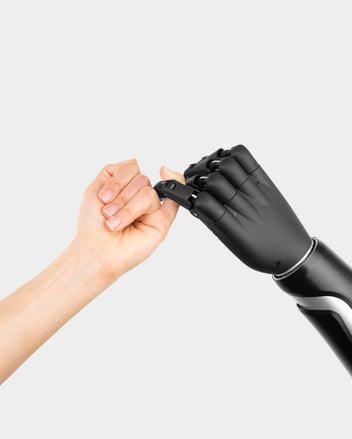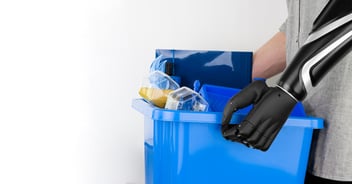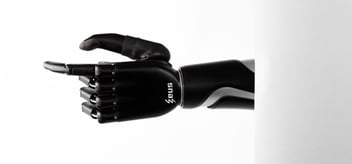How Prosthetic Arm Users Can Manage Sweat Effectively During Peak Summer
As temperatures rise during the summer, coping with sweat becomes a challenge for prostheses users. While sweating is often unavoidable, understanding how to manage sweat effectively can help you stay comfortable and ensure your prosthetic arm works at its best, allowing you to enjoy the season without unnecessary stress. Excessive sweating can cause discomfort and present numerous challenges for the user.
The challenges faced by prosthetic arm users
Skin irritation
The moisture trapped between the skin and the prosthetic socket creates an environment where skin breakdown can occur more easily. Sweat can cause the skin to become irritated, and chafed leading to rashes, blisters, and sores. The moisture trapped between the skin and the prosthetic socket creates an environment where skin breakdown can occur more easily. Sweat can cause the skin to become irritated, and chafed leading to rashes, blisters, and sores.
Change in device operation due to sweat
Increased sensitivity of the electrodes, when exposed to sweat, increase the conduction of electrical signals, leading to overactivity in response to nerve stimulation of the muscles. This occasionally may cause the device sensitivity to change. Regular maintenance ensures the prosthetic arm functions optimally in hot conditions.
Odor and hygiene issues
Sometimes perspiration can create an unpleasant odor, which can be embarrassing and uncomfortable. Additionally, maintaining proper hygiene becomes more challenging as sweat can make it difficult to keep the prosthetic and the skin underneath clean.
Decreased Comfort
A sweaty prosthetic socket can be uncomfortable, leading to a sensation of stickiness or a constant feeling of wetness. This discomfort can discourage individuals from wearing prosthetic arms as much as they might otherwise, limiting their mobility and independence.
Reduced Adhesion
Many prosthetic arms rely on a snug fit and sometimes even adhesive materials to stay in place. Excessive sweating can reduce the effectiveness of these adhesives, causing the prosthesis to slip or shift. This not only impacts functionality but also poses a risk of accidental injury.
Decreased Productivity
Heat and sweat-induced fitting issues in prostheses can negatively impact users' productivity and efficiency.
Effective ways to stay comfortable
Here are some practical tips to help manage sweat effectively and ensure a comfortable experience with a prosthetic arm during peak summer.
Choose the Right Socket
Select a prosthetic socket crafted from high-quality, lightweight materials for optimal comfort and durability. Consult your clinician for expert guidance in choosing the perfect socket that fits your specific needs.
Pick the Right Liner Material
Silicone Liners and Gel Liners made from moisture-wicking materials offer great skin compatibility and reduce irritation. They also provide excellent cushioning and absorb sweat well. These products are designed to pull sweat away from the skin, helping to keep the area dry and comfortable. Textile liners are also lightweight, breathable, and suitable for hot weather.
Keep the Prosthetic Clean
Regular cleaning of the prosthetic socket and the residual limb is essential. Use a dry cloth and brush to clean both the limb and the socket, ensuring that all sweat and bacteria are removed. This helps prevent skin irritation and reduces the risk of infection. Ensure the liner and socket are completely dry before wearing them again.
Apply Antiperspirants
Using antiperspirants on the residual limb can help reduce sweat production. It’s important to choose antiperspirants that are gentle on the skin to avoid irritation. Some prosthetic users find that clinical-strength antiperspirants and creams provide the best results for example Adaptskin 90, Silvadine, Alps Antiperspirant etc. Always consult your clinician and follow their prescription and advice.
Take Regular Breaks
If possible, take breaks throughout the day to remove the prosthetic and allow the skin to breathe. This can help reduce moisture build up and give the skin a chance to dry out.
Adjust the Fit
During the summer, it might be necessary to adjust the fit of the prosthetic arm more frequently. A secure fit can help reduce friction and sweating. Swelling due to heat can change the residual limb's size, so users should consult with their prosthetist about any fit issues.
Stay Hydrated
Drinking a lot of water and staying hydrated can help regulate your body temperature and reduce excessive sweating.
Every prosthetic user has unique needs. Working closely with your prosthetist to develop a personalized plan to manage sweat and related issues can make a significant difference. Whether through specialized products, rigorous hygiene, or professional guidance, effective sweat management can significantly improve the comfort and functionality of your prosthetic use.










